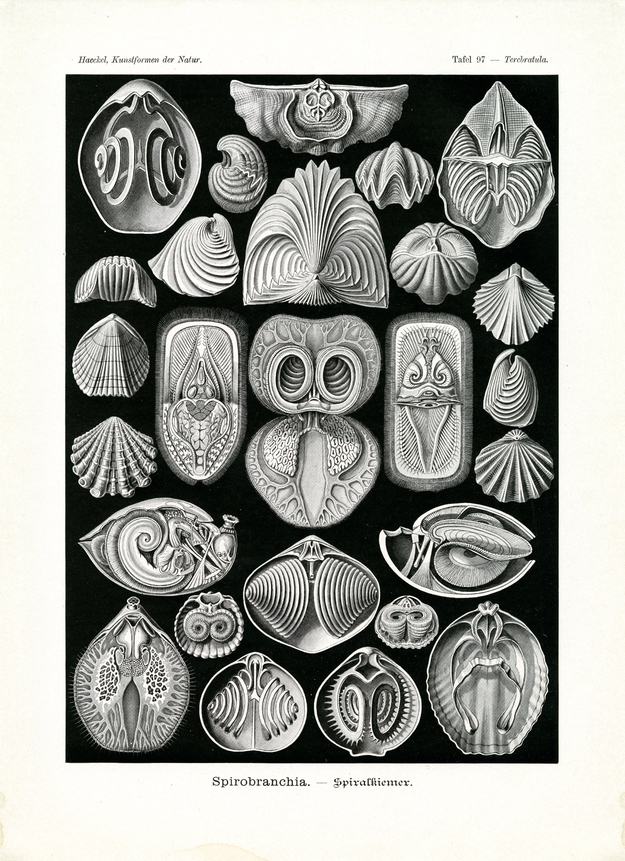Translation of the original German introduction by Ernst Haeckel:
Phylum of Vermalia (Wurmtiere); - main class of Prosophygia (Buschwürmer); - class of Spirobranchia (Spiralkiemer) or Brachiopoda (Armfüßer).
The most varied class of ‘spiral-gilled’ (Spirobranchia) comprises the peculiar group of aquatic animals that were earlier considered mollusks (Mollusca) and closely related to real mussels, (Acephala, plate 55) due to their double-flapped, mussel-like shell.
However, this similarity is superficial; the two shell valves in mussels are situated to the right and the left along the body sides, connected on the dorsum with the help of a ‘lock’, just like in mussel-like crabs, (e.g. Cirripedia, plate 57). The two shell-flaps of Spirobranchia, however, are grown on to the body, at the top as well as the base; the smaller ‘dorsum flap’ (Valva dorsalis) rests like a flat lid on a bigger, more arched stomach flap (Valva ventralis). Its length measures 1-9 cm. The lock (Cardo) that connects the two flaps tightly just like a hinge is situated at the posterior end. It is usually here that the stomach flap is attached to the ocean floor through a stalk. From the pouch-like, flat body that fills only the posterior half of the ‘shell-room’ two thin ‘mantle-lopes’ emerge excreting the shell and carrying bristles at the rim (fig. 13). At the anterior end of the soft body the mouth is situated, surrounded by a pair of huge, distinct arms (Brachia). They are rolled up screw-like and covered with thousands of delicate gill-threats along the outer, convex rim of the screw. The hollow fringes are filled with blood, at the outside covered with flexible cilia; they are used for breathing as well as generating water whirls that supply food to the toothless mouth. The arms themselves are more or less flexible, frequently supported by an internal spiral-shaped lime column; these columns are well visible in the fossil shells too (fig. 1-3, 14-18).
Therefore, the new name “Spirobranchia” is much more appropriate compared to the old name “Brachiopoda”. Closest relatives of these Vermalia are not mussels but ‘moss-animals’ (Bryozoa, plate 23). The ciliated tentacles or ‘sensing-threads’ of Bryozoa correspond to the individual ‘gill-threats’ of Spirobranchia, both arms of the latter to the two arms of the horseshoe-shaped tentacle-carrier or Lophophor of the former (plate 23, fig. 6-8). Young larvae of Spirobranchia show an organization similar to Lophopoda among the Bryozoa. During earlier periods in the history of the earth Spirobranchia played an important role; their fossil shells help composing huge mountain rock-masses; about 3000 fossil species are distinguished; little more than 100 living species are known.
Translation by VR Translators Bangalore
We've scanned the original lithography at 1200dpi on the Epson A3 scanner of A3 scanner huren. You can download a 400dpi JPEG here.
